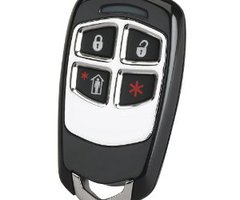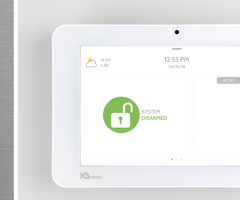How Do I Program a Honeywell 5834-4 to a Qolsys IQ Panel 2 Plus?
You can program a Honeywell 5834-4 to a Qolsys IQ Panel 2 Plus by putting the system into its wireless inclusion mode and then activating the key fob to transmit a signal to the panel. The 5834-4 can only be used in low-security mode, and you must be using the 345 MHz IQ Panel 2 Plus.

The Honeywell 5834-4 is a wireless key fob device that is used to arm and disarm a system, activate emergency panics, and trigger other auxiliary functions. It is part of the Honeywell 5800 Series, and it operates at a wireless frequency of 345 MHz. This makes it compatible with the 345 MHz Qolsys IQ Panel 2 Plus. This is the one with the silver and white box shown above. You cannot use the 5834-4 with the 319.5 MHz IQ2+ or the 433 MHz IQ2+. You also cannot use the 5834-4 with an IQ2+ while the fob is in its high-security mode (red LED light). You must put the key fob into its low-security mode (green LED light). More info on high vs. low security mode can be found here.
When enrolling the Honeywell 5834-4 with a Qolsys IQ Panel 2 Plus, by far the most common selection is to enroll the device as an actual key fob. However, you also have the option to enroll each individual input on the key fob to the IQ Panel 2 Plus as other Sensor Types using individual Loop Numbers. Each input (button) on the 5834-4 uses a different Loop Number. It is also possible to program dual-button inputs on the 5834-4 in this manner. The dual-button inputs use a Serial Number, or Sensor DL ID, that is one digit higher than the Serial Number used with the single button inputs. See the diagram below for an outline of the different inputs and their assigned Loop Numbers.

For this FAQ, we will just stick to standard, single-button programming with the device enrolled as a standard key fob. This is how the vast majority of users will want the 5834-4 to operate on the Qolsys IQ Panel 2 Plus. Below we have a list of the single-button inputs for the 5834-4 and how they behave when the fob is programmed in this way:
- Button 1 or A: This is the upper-left button, or the picture of the locked lock. Pressing and holding this button will put the IQ Panel 2 Plus into Armed Away mode.
- Button 2 or B: This is the upper-right button, or the picture of the unlocked lock. Pressing and holding this button will disarm the IQ Panel 2 Plus.
- Button 3 or C: This is the lower-left button, or the picture of the person in the house. Pressing and holding this button will put the IQ Panel 2 Plus into Armed Stay mode.
- Button 4 or D: This is the lower-right button, or the picture of the asterisk (*). Pressing and holding this button will trigger an audible intrusion alarm on the IQ Panel 2 Plus. Only press this button in an emergency.
By programming the Honeywell 5834-4 in this manner, the device will only take up one (1) wireless zone on the system. One other thing to keep in mind, remember that any command is triggered by pressing and holding the button for a couple of seconds. If you just press and immediately release the button, then the command will not go through. This is to prevent accidental inputs. You will know that a command was sent from the 5834-4 because its green LED light will flash. Remember that if the red LED flashes, then the key fob is in its high-security mode, and you must switch it to low-security. Please see the link we provided earlier in this FAQ.
Complete the following steps to program the Honeywell 5834-4 to the 345 MHz Qolsys IQ Panel 2 Plus as a standard key fob device where each button will behave as explained above:
1. Enter auto enrollment mode. The first step is to put the Qolsys IQ Panel 2 Plus into its auto enrollment mode. From the main screen of the system, click on the small grey bar at the top, and then choose settings > Advanced Settings > enter the Installer Code or Dealer Code (defaults are 1111 and 2222, respectively) > Installation > Devices > Security Sensors > Auto Learn Sensor. The Qolsys IQ Panel 2 Plus will now be in its auto enrollment mode.
2. Activate the Honeywell 5834-4. With your Honeywell 5834-4 Key Fob in its low-security mode, press and hold one single button on the fob. It doesn't matter which button, just as long as you don't press two (2) buttons at once for a dual-button input. This is because you are enrolling the Serial Number associated with single button inputs. The Qolsys IQ Panel 2 Plus should receive the signal from the 5834-4 and ask you if you want to enroll. Verify the serial number matches the one on the 5834-4, then press OK.
3. Configure the zone settings. You will now be required to configure the settings for the wireless zone. You can leave Sensor DL ID alone, as the system already knows the fob's Serial Number since you auto-enrolled it. For Sensor Type, set it to Key Fob. For Sensor Group, set it to 1-Mobile Intrusion. For Sensor Name, set a name that will make it easy for you to recognize the key fob. For Chime Type, leave it at none, unless you want the system to chime when you activate the fob. Voice Prompts is usually left On to have the panel make a verbal annunciation of the change in system arming status. Source should be kept at SecurityRF-345. Once you have finished configuring the zone settings, press the Add New button at the bottom to complete the process.

4. Return home. Now that you have successfully enrolled the key fob, press the picture of the house at the bottom of the screen to return to the home screen. The 5834-4 Key Fob is saved to the IQ Panel 2 Plus once you hit Add New.
Did you find this answer useful?
We offer alarm monitoring as low as $10 / month
Click Here to Learn MoreRelated Products



Related Categories
- Answered

